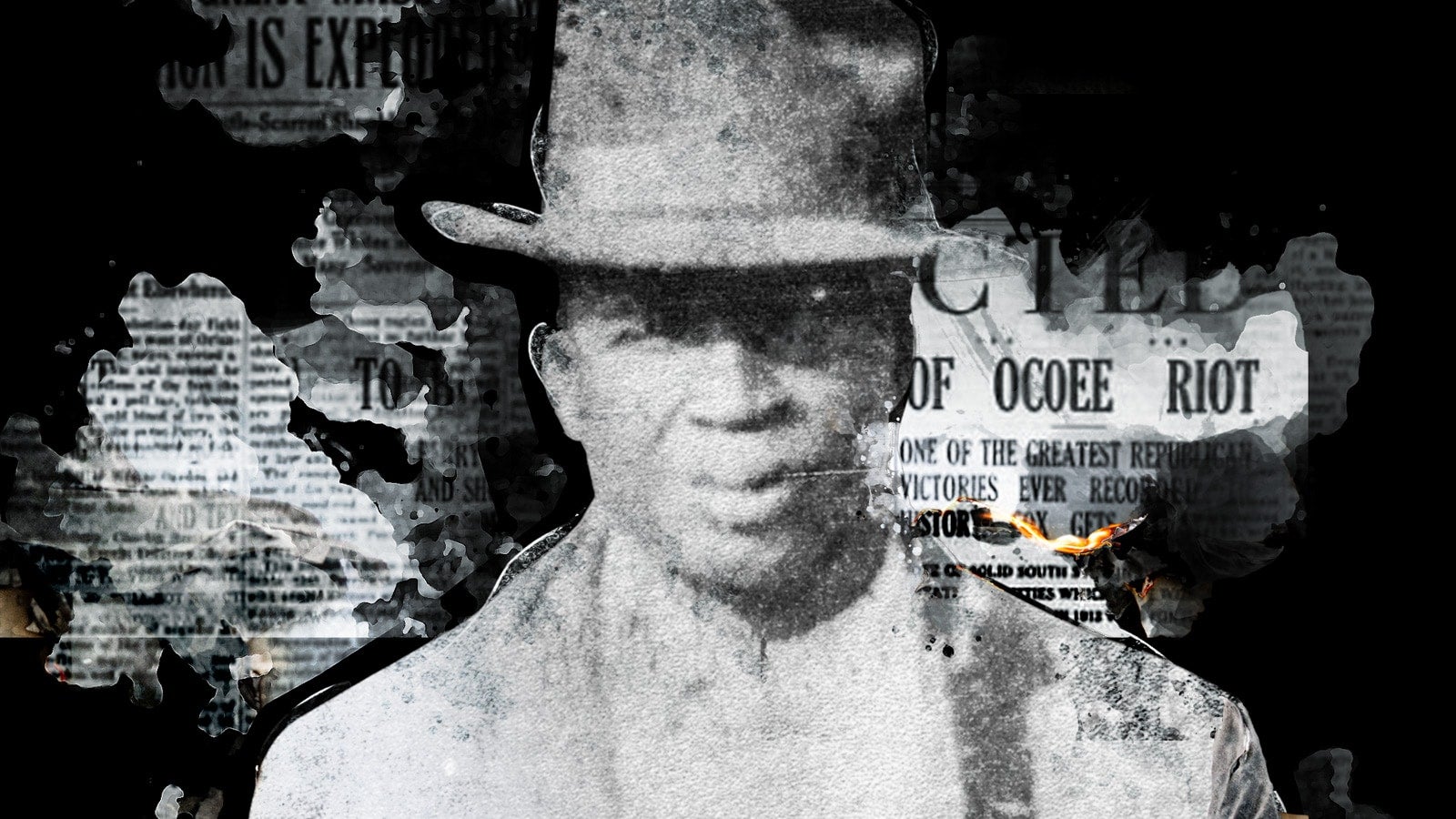
The Truth Laid Bare
Fall 2020 | By Robert Stephens
 ladys Franks Bell woke up three minutes ago and her phone is ringing — again. “I’ve been getting so many calls these past few months,” she says. “People want to ask me what happened to my dad’s family that night. Daddy will always be a hero to a lot of people.”
ladys Franks Bell woke up three minutes ago and her phone is ringing — again. “I’ve been getting so many calls these past few months,” she says. “People want to ask me what happened to my dad’s family that night. Daddy will always be a hero to a lot of people.”
“That night” was Election Day, November 2, 1920. Known as the Ocoee massacre, it is one of the most horrific examples of racial hatred imaginable. Dozens of Black people were killed. More than 200 others were run out of town in the then-unincorporated part of west Orange County, fleeing from bullets and their burning homes. Among them: 18-year-old Richard Allen Franks, who led his six younger siblings through muck and alligator-infested water in the middle of the night to safety in Plymouth, Florida (where Franks Bell was born, raised and lives to this day at the age of 81). On his back, Allen, as he was known, carried his brother, Cornell, who had paraplegia.
“Daddy was about 6 feet tall with strong hands,” Franks Bell says. “But he was a giant of a man because he cared about everyone — I mean everyone. You know, the details of that night are in my book. That’s what everyone seems to want.”
She’s referring to Visions Through My Father’s Eyes, which she self-published in 2015. The acts inflicted by a mob that night and the fear that followed, it’s all in there. But in her conversations, she’d like to focus on something else: “My father never allowed any room for hate. None.”
And that leaves anyone who’s listening to wonder: “How could that possibly be?”
Like Frank Bells
and other Black children
who grew up on the west side of Orange County through most of the 20th century, Francina Boykin was told to avoid Ocoee. The abusive treatment of Black people, however, wasn’t confined to the Ocoee city limits. Boykin had rocks thrown at her whenever she walked from her home in Apopka to the neighborhood store. Her grandfather was badly beaten by members of the Ku Klux Klan.
“When it came to Ocoee,” she says, “we just didn’t go there, and we didn’t ask why.”
Unspoken memories of “that night” haunted the region for nearly 80 years. Any kind of redemption had been muffled in the silent chasm between then and now, between white and Black.
“We have to acknowledge the bad part of our history,” says UCF Associate Professor of History Robert Cassanello, who has spent 15 years researching Ocoee and trying to understand what went so terribly wrong there. “That’s how we grow — by seeing ourselves in it.”
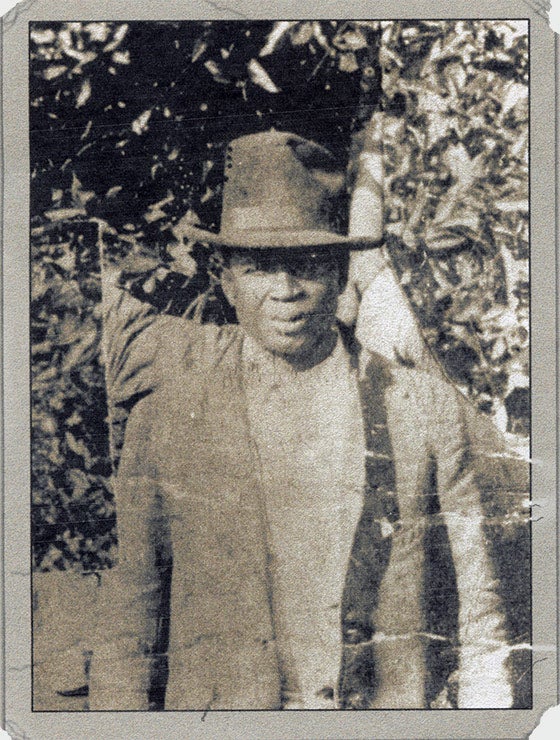
A prominent Ocoee resident, July Perry was beaten, shot and lynched as a warning to other Black citizens who dared to vote. He was one of the 30 to 80 residents killed and whose homes were burned down during the Ocoee massacre in 1920.
So let’s first see ourselves in the early 1900s. Black people were moving in from the Carolinas, Georgia and Alabama. They found opportunity in the fruit-bearing land of Orange County and bought parcels of citrus groves and made them flourish. Boykin remembers a gentleman in Apopka once telling her, “The people from Ocoee would come riding over here on horses with gold tassels. We thought, ‘They must be doing well over there.’ ”
By 1920, some Black Ocoee residents were driving nice cars and planning to send kids to college. One of them, July Perry, had become a prominent businessman who would help broker land deals and arrange work for people. He also began registering Black residents to vote.
“They were doing what Booker T. Washington had proposed in his Atlanta Compromise Speech in 1895,” says Connie Lester, UCF associate professor of history and editor of the Florida Historical Quarterly. “He said that by working hard, acquiring property and becoming a vital part of the economy, white people will see your contribution and accept you as voters.”
The test of acceptance came with the 1920 presidential election: Republican Warren Harding versus Democrat James Cox. The NAACP actively registered Black voters throughout Florida. John Cheney, a white attorney and former judge running for U.S. Senate, strongly encouraged Black residents in Orange County to exercise their right.
“I’m sure they were excited to vote,” says Robert Hickey, whose grandfather, John Hickey, had grand plans for the 120 acres he owned in Ocoee.
But an opposing force loomed. Cheney received a letter saying if any Black residents attempted to vote “there will be serious trouble.” The daughter of a prominent white Ocoee official would tell a researcher nearly 50 years later that “90 percent of all law enforcement officers, judges, public servants and lawyers in Winter Garden and Ocoee were Klan members.”
“The KKK held parades around the state in a show of intimidation three days before the election,” says Cassanello. “The cultural touchstones of the time were being threatened — white supremacy among them. When that happens, it creates angst, sometimes in the form of violence.”
Time and silence
have slightly blurred
the exact sequence of events on November 2, 1920, but most accounts agree on this montage: Mose Norman pulled his car up to the Ocoee polling precinct that morning to vote. He was denied and drove to Orlando to tell Cheney, who told Norman to go back and take the names of anyone suppressing his right. When Norman returned to Ocoee with Cheney’s message, gunshots were fired. Norman escaped. That night and into the next morning, Col. Sam Salisbury rallied a mob of as many as 200 white men from around the region to find Norman. They surrounded the home of Norman’s friend, July Perry. More gunfire ensued. The people living in Ocoee’s Black community ran for safety. Some were caught. Some were shot. Some were never heard from again.
Perry was beaten, shot, jailed, dragged and lynched.
Stories over the years have said between 30 and 80 Black people died that night. The stories also confuse who shot first and who said what.
“The particulars might be debated,” says Lester, “but they can’t get in the way of the substance. That’s the issue that lingers.”
Armstrong Hightower hid in the citrus groves with his sister. His description 80 years later would paint a vivid picture of the particulars and substance: “That’s the night the devil got loose in Ocoee.”
The fires set by the mob burned a hellish hole right through the Black community. Norman fled to Stuckey, Florida, and then to Harlem. Perry’s wife escaped to Tampa with their teenage daughter, Coretha. John Hickey had to abandon his 120 acres and his dreams.
“Everything he pursued came to a screeching halt,” says Robert Hickey, “and there was nothing he could do about it.”
The entire horrific
truth began
to be erased
as soon as July Perry’s body was lowered from the light pole (some sources say it was a tree limb) near the Orlando home of John Cheney, who lost the Senate race that night.
The 1920 census says 255 Black residents and 560 white residents lived in Ocoee. Within months of the Election Day massacre, no more than two Black residents remained. From the 1930s into the 1970s, not a single Black person lived in the city. Few would even go near it as the eerie silence permeated the entire region.
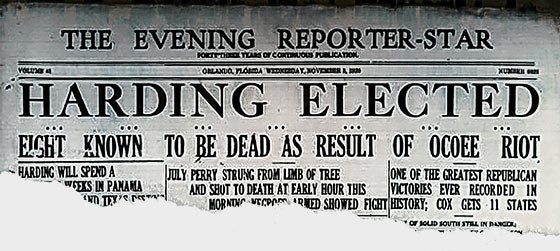
The day after the election, the Orlando Sentinel — then known as The Evening Reporter-Star — reported eight deaths and July Perry’s lynching, but the details and total number of deaths and destruction were far more sinister.
“After the massacre, newspapers advised that order had been restored and everyone should stop talking about whatever happened,” Lester says.
A 2019 report from the Office of Program Policy Analysis and Government Accountability includes an item that apparently floated within the sea of denials. It’s an advertisement in the December 12, 1920, edition of the Orlando Sentinel: “Special Bargains. Several Beautiful Little Groves Belonging to the Negroes That Have Just Left Ocoee. Must Be Sold—See B.M. Sims.” Sims was one of Ocoee’s wealthiest white landowners.
In July 1921, the Orlando Sentinel reported that another angry mob had “injured” a Black man, George Betsy, because “he talked too much about the trouble at Ocoee last November.” The next newspaper article known to be published with any hint of the real story would be 65 years later, in 1986, the year Ocoee hired its first city worker.
So how did the truth disappear about what the Orange County Regional History Center calls “the largest incident of voting-day violence in United States history?” As the character Roger “Verbal” Kint popularized in the movie The Usual Suspects: “The greatest trick the devil ever pulled was convincing the world he didn’t exist.”
This year, 100 years
after the massacre,

When it came to Ocoee, we just didn’t go there, and we didn’t ask why.
— Francina Boykin

Gov. Ron DeSantis signed a law directing schools across Florida to teach students about Ocoee’s Election Day massacre. A section of State Road 438 in Ocoee has been renamed July Perry Highway. A historic marker will be dedicated in another part of the city.
“What you see now is the easy part,” Boykin says.
The hard part has been finding people to open up. “White people took great pains to not breathe a word about it,” says Cassanello. “The Black people, like anyone who experiences trauma, probably didn’t want to relive it.”
Robert Hickey says he would hear bits and pieces about the massacre while eating oranges with his grandparents in the 1950s. “But,” he says, “I had no idea of the gravity of it all. I just knew my grandfather was bitter about something.”
Bitterness. Trauma. Deceit. It all simmered. Fear was the lid that kept it from boiling over.
“To talk about it was to perhaps invite more problems,” Lester says.
Author Zora Neale Hurston penned a story in 1939 titled The Ocoee Riot, which wasn’t published until 1989. In 1969, Lester Dabbs, a white educator new to the city, heard whispers about an event in 1920 and made it the topic of his postgraduate research at Stetson University. Knowing the thesis might spark violence, he decided to keep it private until all of his sources had died. Dabbs instead became a community mediator.
And what about Coretha Perry, July Perry’s daughter who escaped that night? She said she would never say the word “Ocoee” again or “even look at it on a map.” But she could not ignore one constant reminder: a scar on her arm from a bullet.
There was one place, though, where someone had been sharing the story about the unspeakable: in Plymouth, at Allen Franks’ dining room table.
“Daddy sometimes had tears in his eyes when he talked because he couldn’t understand why anyone would shoot people and take everything they owned,” Franks Bell says. “You could still sense fear. But never hate. I had white friends over to our house to play. Daddy was a father figure to them, too. He’d say, ‘We’re all God’s children.’ ”
Allen Franks died in 1994. “I still miss him, especially now,” Franks Bell says. “We could use more people like him today.”
Boykin is
as candid as ever
at the age of 70,
as she looks out the window of the Orlando law firm where she’s worked for 33 years. She acknowledges the marching and the protesting of the Black Lives Matter movement.
“We can’t just say ‘forget it’ and move on from injustice,” she says. “But violence and shouting won’t help. We all need to listen to each other. Then we can make progress. We proved it.”
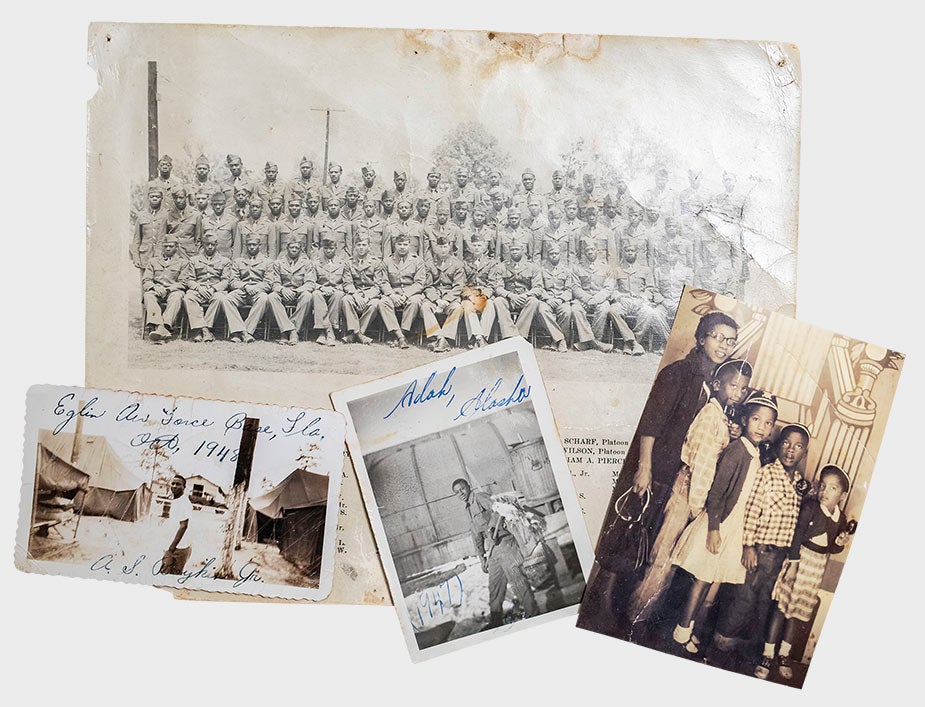
Despite being the victim of continued racism in the decades following the Ocoee massacre, Francina Boykin was among those who convinced the community to break its own silence on an ominous past so it could begin the slow process of change.
She says Ocoee’s “Rosa Parks moment” came in the late 1990s. Curtis Michelson, a white man unfamiliar with Ocoee’s reputation, encouraged a Black friend with a soothing voice to intern at a radio station. The friend quit that same week, telling Michelson, “Ocoee’s no place for a brother.”
So Michelson brought a group of people together — students and professionals, old and young, Black and white — to find out why race had torn the community apart. They called themselves Democracy Forum.
“We researched facts and asked questions,” Boykin says, “and we found truth.”
The documented evidence of the Ocoee massacre was easier to find than the group anticipated. The death certificate for July Perry showed cause of death: “By being hung.” Census records showed that the Black population of Ocoee disappeared overnight after the 1920 election. They found a letter in the NAACP’s anti-lynching files, written by Ocoee resident Annie Hamiter. She’d smuggled the letter into a crate of oranges bound for a buyer in Ohio, apologizing for the delivery being late. “One of the wickedest happenings of a lifetime happened here.” And she explained how all the Black residents had been forced from their homes.
“That was powerful,” Boykin says.
People gradually came forward to talk. Armstrong Hightower experienced the tragedy firsthand. When a writer for a national news outlet arrived in 2001, Hightower, then in his 90s, asked, “What took you so long?”
Eventually, for every Black descendant who shared a piece of the story, a white descendant would do the same — some of them apologizing for their families’ getting the story wrong all along.
Franks Bell would like
more people to read her book and learn from her father’s example.
“Despite everything Daddy experienced, he leaned on his Christian faith to overcome hate. He was all about love, no matter what. That’s why he’ll always be a hero.”
At Greenwood Cemetery in Orlando, three plots offer irony and maybe some sort of unintended symbol of reconciliation. Here rests John Cheney, the man who wanted so badly to usher in the day for Black people to vote freely. Also here is Col. Sam Salisbury, the man who prevented them from voting in 1920 by stirring up the mob. The most visited site, though, is a short walk away. This is where, on Election Day in 2018, carloads of Black and white voters came to place their “I Voted” stickers at the headstone of July Perry, 98 years after he and his neighbors were denied their right to do so.
“Can you believe it?” Boykin says.
 Connie Lester became aware of Ocoee’s Election Day massacre shortly after moving to Florida in 2005. Five years later, the UCF associate professor of history helped establish the Regional Initiative for Collecting History, Experiences, and Stories (RICHES).
Connie Lester became aware of Ocoee’s Election Day massacre shortly after moving to Florida in 2005. Five years later, the UCF associate professor of history helped establish the Regional Initiative for Collecting History, Experiences, and Stories (RICHES).
“There are other places like Ocoee,” Lester says. “Places where individual horror was never recorded. But that doesn’t mean history is gone. It’s just hidden, sometimes among the people.”
Speaking with descendants from the Ocoee massacre has had an impact on Lester and on the mission of RICHES. Colleagues and students record conversations and follow leads to physical documents, all of which are digitized and preserved for easy access. They’re doing the same for others who have been reluctant to share their stories — veterans and people in the LGBTQ community, among them.
“It’s too easy to say movements, like the civil rights movement, fix everything,” says Lester. “It’s a mistake if we don’t listen and address the pain. Then we can keep a record of it so future generations don’t forget.”